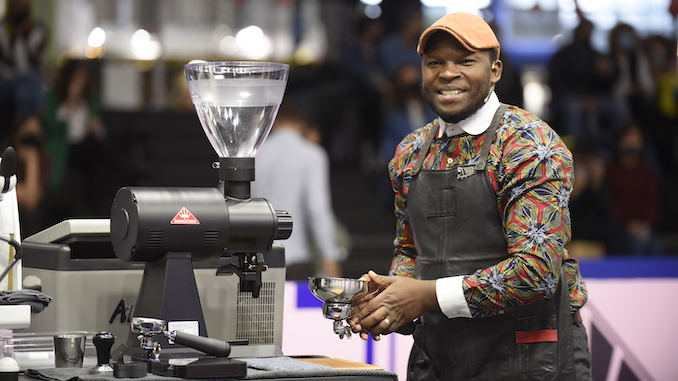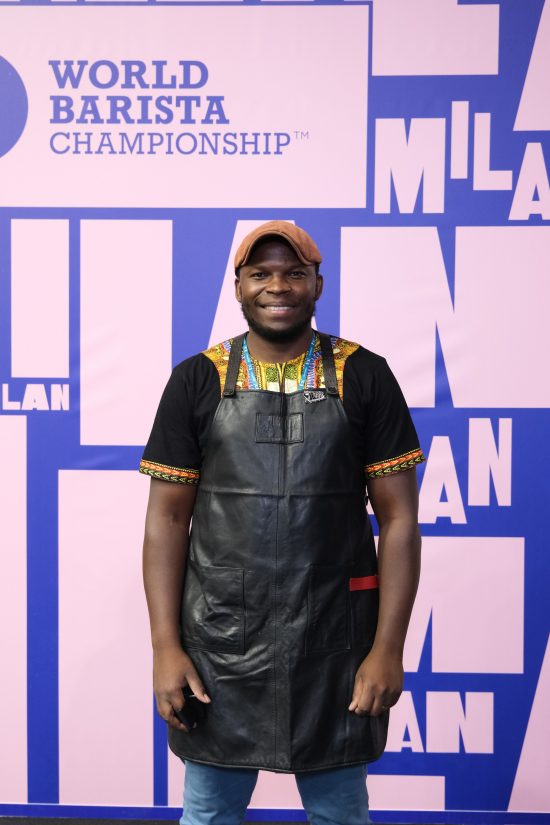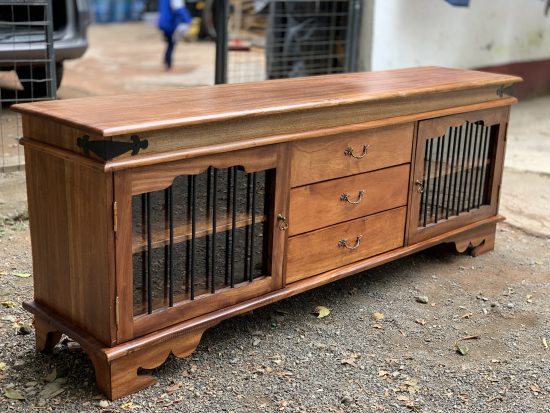
The fifth-place winner shares with us his unique competition coffee choice, and more about coffee growing in Kenya.
BY KATRINA YENTCH
BARISTA MAGAZINE ONLINE
Cover photo courtesy of World Coffee Events

Kenyan barista champ Martin Shabaya has been destined for World Barista Championship success since 2017. Martin has crushed the competition at the national level in Kenya a whopping four times, along with achieving runner-up status at the Fushan Coffee International Barista Competition of China in 2018. Upon scoring the 2017 WBC Wild Card in Seoul, South Korea, notable figures in the coffee world flirted with Martin, eager at the opportunity to collaborate with him for global championship victory. And so, 2015 World Barista Champ Sasa Sestic was granted the opportunity as his coach for this year’s competition, along with help from producer David Maguta.
Martin placed fifth at the 2021 WBC with his routine, which used an eccentric yet thoughtful blend of Batian and Ruiru for his espresso choice. Through his colorful and bright presentation, Martin served the espresso after pouring it over a bed of charcoal to showcase David’s own processing techniques at the farm level. You can watch Martin’s performance here.
In this interview, we speak with Martin more about his espresso choice, Kenya’s coffee-growing challenges, and his passion for professional woodworking.
Katrina Yentch: You worked with your friend and producer David Maguta to source the Batian and Ruiru—what other varieties of coffee were you considering before competition? What were you looking for in what would be your final espresso choice?
Martin Shabaya: I was looking for balance, complexity, and cleanness in my cup of espresso. I was planning to use pure Kenyan coffee, and I was leaning more towards the SL (varieties), as these are the renowned top varieties we have in Kenya in terms of cup quality.
Of course this was before I met David, and with the help of Sasa Sestic, we worked together on lots of experiments and processing techniques on different varieties David has in his farm. Ruiru and Batian really turned out special with the new CM lacto fermentation.
I was really excited when we finally made the decision to go with a blend of the two varieties that are popular with the farmers here in Kenya, but not popular on the world stage. So, I knew I had something exceptional, and by focusing on the positives, we were able to elevate these coffees to new interesting heights, and give new hope to the farmers who have these varietals in their farms to show them that quality is very achievable—regardless (of) the variety.
Being from a producing country is an opportunity to put your country’s coffee on the world stage and in the public eye. So, what are some Kenyan coffee trends that coffee buyers should be paying attention to in the near future? Processing techniques, special varieties, challenges, etc.?
Coffee in Kenya was the crop of “aging farmers.“ Many young people are now getting back to the farms as they’ve realized coffee can be an effective cash crop, and even a career to look up to. For instance, David is only 27, and yet he is so open-minded in trying new processing techniques and new ways of cultivating and growing less popular varieties of coffee to unlock their potential—like (the aforementioned) Ruiru and Batian, which some farmers are not very keen on, from a negative attitude towards the varieties.
Environmental stress associated with climate change is a big factor here in Kenya, as the changing weather patterns are so challenging in achieving quality at the farm level. For example we’ve had unreliable rainfall recently, which has caused some berries to ripen prematurely in a lot of farms.
To add (insult) to injury, I experienced recently that we have so much more to learn, especially when it comes to drying our coffees on the dry beds. With the increased temperatures, coffees are drying too fast, lessening the evenness and consistency throughout the bean; if not controlled, the flavors you taste at origin might fade by the time you receive your coffee.
You’ve competed many times now after discovering the joys of competing in 2014—what are a couple of things you’ve worked on improving the most?
All the while I never realized how connection, innovation, and teamwork can be the ultimate recipe for success. I don’t know where to start. I have really learnt a lot in every aspect of the competition, be it on tasting and deciding which coffee to compete with, tasting and describing the espresso (even just a few minutes before getting on WBC stage—this was interesting), how to create a signature drink and the choice of ingredients, among many other things, including the best way to express my idea of specialty coffee in the most simple way.
Now that you placed fifth at WBC, what’s next? Do you ever hope to become a WBC trainer yourself?
Placing fifth in the World Barista Championship is by far the best thing that has ever happened to me in my career. Now I can imagine the joy of sharing knowledge and inspiration with someone of the same level of passion—anything is achievable! Even more than finals! So yes, absolutely, I will want to groom a great barista champion someday.

What is your favorite brewing method, and your current favorite “everyday coffee“ for sipping?
V-60 is my preferred method of brewing. It’s cheap and simple, as you have most of the control in your hands. If beautifully executed, it always results in a delicious cup of coffee. My “everyday coffee“ is a beautiful Kenyan natural.
I read that you enjoy woodworking, and that you were able to merge that with your coffee passion during the pandemic. What projects did you work on?
Indeed, I really enjoy simple woodworking, mostly for home furniture, which I do as my side job. I had been doing it to unwind and out of passion even before the pandemic, but I dived deeper into it during the pandemic after I lost my job, and so I had to make this a steady source of income to sustain my family. The business has mushroomed up in a special way, which I can only attribute to God for His marvelous Grace upon me.

